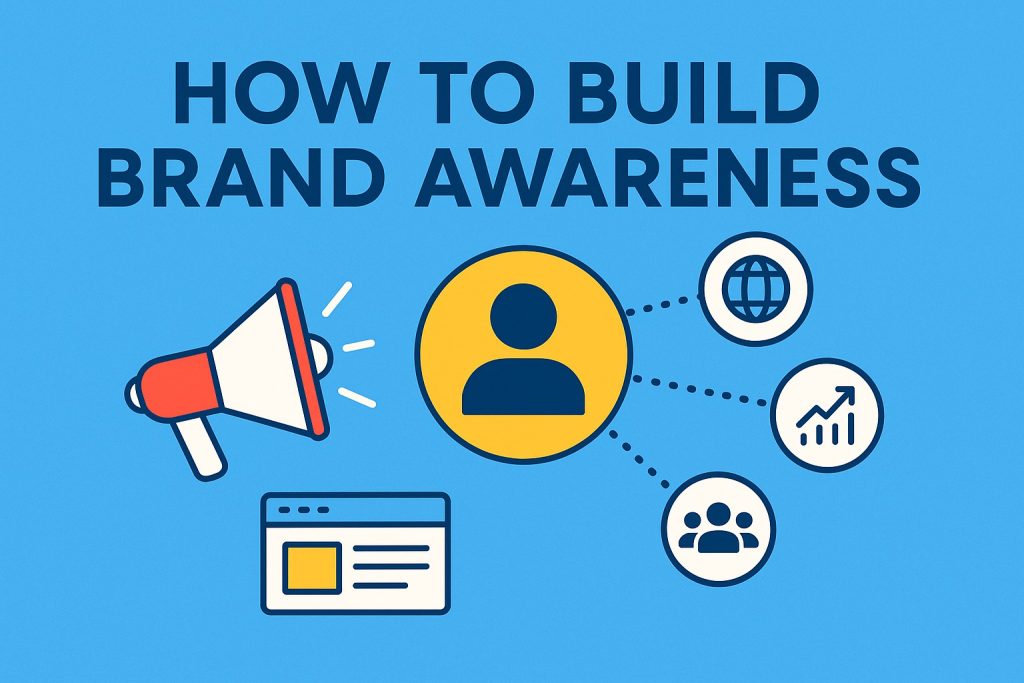Build brand awareness is the crown jewel of business success in an age where choices flood every corner of life, both online and offline. A remarkable product alone no longer guarantees recognition—it takes a brand that people can instantly recall, trust, and feel connected to on a deeper, emotional level. True awareness carries a sense of prestige, where your name stands tall above the noise and inspires confidence. Businesses that achieve this distinction do more than capture attention; they earn loyalty that lasts, engagement that grows stronger over time, and trust that feels unshakable. It is this royal foundation that elevates a brand from being noticed to being remembered and revered.

For marketers and entrepreneurs, understanding how to build brand awareness is the foundation for growth. It influences customer decisions, supports premium pricing, and fuels sustainable success. At the same time, awareness strategies must evolve with digital trends. If you want a broader perspective on complementary tactics, you may also explore Best Digital Marketing Strategies. This article provides a step-by-step guide, blending proven methods with modern approaches to make your brand memorable and trustworthy in a competitive world.
What Is Brand Awareness?
Before diving into strategies, it’s important to clarify what brand awareness means. Brand awareness refers to how well consumers recognize and recall a company, product, or service. It’s not only about remembering the name but also associating it with values, experiences, or benefits.
There are two main forms:
- Aided awareness: Consumers recognize your brand when prompted. For example, if asked about smartphone companies, someone might recall “Apple” once mentioned.
- Unaided awareness: Consumers spontaneously recall your brand without cues. For instance, when asked, “What’s your favorite soft drink?” many will instantly reply “Coca-Cola” or “Pepsi.”
Strong awareness builds a psychological anchor, ensuring customers turn to your brand first.
Know Importance of Brand Awareness
Brand awareness is more than a marketing buzzword—it drives real business outcomes. Brands with high awareness enjoy faster customer acquisition, stronger loyalty, and higher perceived value. Before exploring tactics, let’s understand why it matters.
First, awareness builds trust and credibility. Consumers prefer to buy from companies they know. Second, it increases market share by ensuring your brand remains top-of-mind during purchasing decisions. Third, recognizable brands can charge premium prices, as customers associate them with higher quality. Lastly, awareness enhances marketing ROI—when people already recognize your brand, they are more receptive to ads and promotions.
Simply put, brand awareness acts as the foundation for growth, positioning your business for long-term success.
11 Core Strategies to Build Brand Awareness
Developing strong brand awareness is not about a single tactic but a mix of consistent, integrated strategies. Each step strengthens recognition and trust, making your brand stand out. Below, we’ll explore the most effective methods.
1. Define Your Brand Identity
Every awareness campaign begins with identity. Without a clear brand foundation, marketing efforts may lack direction or consistency.
Your brand identity includes mission, vision, values, and personality. For instance, is your brand focused on innovation, affordability, luxury, or sustainability? Alongside this, create a distinct visual identity—logos, colors, fonts, and tone—that stays consistent across all platforms.
When customers encounter a coherent and memorable identity, it strengthens recall. Think about how Apple’s minimal design and Nike’s slogan “Just Do It” instantly trigger brand recognition. Identity shapes awareness at every stage.
2. Content Marketing
A great content marketing strategy is one of the most powerful tools to build brand awareness. It allows businesses to educate, engage, and inspire audiences while showcasing expertise.
Start with blogs that solve customer problems, answer common questions, and highlight industry insights. Complement these with videos, podcasts, and infographics to diversify your reach. Content should not only be promotional but also offer genuine value. Evergreen content (like “how-to” guides) works especially well for long-term awareness.
For deeper insights into positioning content effectively, you can read Content Marketing vs. Product Marketing. The right approach ensures your brand becomes a trusted source, encouraging repeat visits and higher recognition.
3. Leverage Social Media
Social platforms are essential for building awareness in the modern age. They allow direct interaction with audiences while amplifying brand stories.
Success comes from consistency—posting regularly, using a unified tone, and engaging with followers. Use visual content like reels, stories, and infographics to boost visibility. Experiment with branded hashtags and community engagement to expand reach.
Each platform serves different goals: LinkedIn for B2B authority, Instagram for visuals, TikTok for viral campaigns, and Facebook for community building. The key is to adapt your brand voice without losing consistency.
4. Search Engine Optimization (SEO)
SEO is a cornerstone of digital awareness. It ensures your brand shows up where customers search for solutions.
Start with on-page SEO: optimize titles, descriptions, and headings with relevant keywords like build brand awareness. Build authority with backlinks and guest posts. Use local SEO if targeting specific regions. Finally, prioritize technical SEO by ensuring mobile responsiveness and fast site loading.
When people find your business at the top of Google, it not only drives traffic but also builds trust. To explore the basics, see of Search Engine Optimization.
6. Paid Advertising
Paid campaigns can accelerate brand awareness when organic growth is slow. They help reach large, targeted audiences quickly.
Options include search ads (appearing when users search keywords), display ads likes CPC Advertising, CPM Advertising (visual banners on websites), and social media ads (Facebook, Instagram, LinkedIn). Video ads on platforms like YouTube are especially effective for recall.
When executed well, advertising creates familiarity even before purchase intent exists. However, it should always complement—not replace—organic strategies.
7. Influencer Marketing
Influencer marketing bridges trust by associating your brand with people audiences already admire.
Influencers fall into two categories:
- Micro-influencers (5k–50k followers): Niche-focused and highly engaging. Learn how to find micro influencers, so that you can build your brand on demand.
- Macro-influencers (100k+ followers): Broad exposure but less personal.
Partner with influencers who share your brand values to ensure authenticity. Customers are more likely to trust recommendations when they feel genuine. This human connection makes influencer marketing a reliable awareness-building tool.
8. Partnerships & Collaborations
Collaborations extend awareness by connecting with new audiences.
Consider co-branding campaigns, cross-promotions, or community events with complementary businesses. Partnering with a well-established brand allows credibility to transfer. Corporate social responsibility (CSR) initiatives also create a positive public image.
For example, a local coffee shop collaborating with a bakery for joint promotions boosts exposure for both brands. Partnerships multiply awareness faster than isolated efforts.
9. Experiential Marketing
Experiences make brands unforgettable. Instead of telling customers what you stand for, experiential marketing allows them to feel it.
Examples include pop-up stores, product demonstrations, or sponsoring cultural events. These hands-on experiences build emotional connections. Research shows customers remember experiences longer than advertisements, making this a strong tool for recall. Rather than telling people what your brand is, you let them experience it firsthand through pop-up events, immersive installations, or live demos. These interactions create emotional memories. To dive deeper into the possible formats, see Types of Experiential Marketing. Experiential efforts often leave deeper impressions than ads because they engage multiple senses and deliver unique stories.
Experiential marketing is especially effective for lifestyle brands where values and identity matter as much as the product itself.
10. Public Relations (PR)
PR remains a cornerstone for building authority-driven awareness.
By securing media coverage, writing press releases strategies, and contributing guest articles, brands gain exposure on trusted platforms. Appearing in newspapers, online magazines, or podcasts enhances credibility and reinforces expertise.
The key lies in storytelling—framing your brand as innovative, reliable, or socially responsible. Effective PR creates long-lasting impressions and positions your business as an industry leader.
11. Employee Advocacy
Employees are often overlooked assets in brand awareness campaigns. Their authentic voices can significantly influence perceptions.
Encourage staff to share company updates, success stories, or behind-the-scenes content on LinkedIn and other networks. This amplifies your brand reach while adding a human element.
When employees are proud to represent your company, their advocacy becomes a powerful trust signal. It also boosts morale internally, aligning teams with the larger vision.
Measuring Brand Awareness
You can’t manage what you don’t measure. Tracking progress ensures your strategies work and evolve.
Important metrics include:
- Website traffic & branded searches: More people searching for your brand name is a good sign.
- Social metrics: Monitor impressions, shares, mentions, hashtag usage, and follower growth.
- Surveys & brand recall research: Ask audiences, “Which brands come to mind for X?”

Use tools like Google Analytics, social media dashboards, or third-party brand tracking platforms. Regular measurement reveals which channels drive attention and where to double down.
How Long does it take to Build Brand Awareness
Building brand awareness is not an overnight process—it requires consistent effort, strategy, and time. On average, it can take three to six months to start noticing measurable improvements in awareness through tactics like SEO, social media, and content marketing. However, achieving strong, lasting recognition often takes one to two years of consistent branding, storytelling, and customer engagement. The timeline depends on factors such as industry competition, marketing investment, and the clarity of your brand identity. Startups with creative campaigns may grow faster, while traditional businesses might need longer to build trust and recognition. The key is consistency—delivering the same message, values, and visuals across all touchpoints. Over time, this steady approach ensures your brand moves from being unfamiliar to becoming a trusted and memorable name in the minds of customers.
Common Mistakes to Avoid
Even with good intentions, awareness campaigns can go off course if you’re not careful.
One danger is inconsistency—shifting visuals, messages, or tone between platforms confuses your audience. Another mistake is relying too heavily on paid ads without building organic strength. Lastly, ignoring the customer experience can undo all your effort—if someone gets a bad product or service, their negative perception undermines awareness.
Avoid these pitfalls by staying steady, diversified, and customer-focused.
Key Takeaways
Building brand awareness is a long game—but one of the most impactful investments a business can make. From defining your identity and crafting content to leveraging SEO, influencers, partnerships, experiential events, and employee voices, each tactic layers recognition and trust. Over time, these efforts combine to make your brand memorable, respected, and preferred.
As a next strategic step, align your branding efforts with a structured growth roadmap: check out how to frame your growth with a practical Business Plan. Consistency, clarity, and persistence will transform your brand from unknown to unforgettable.


